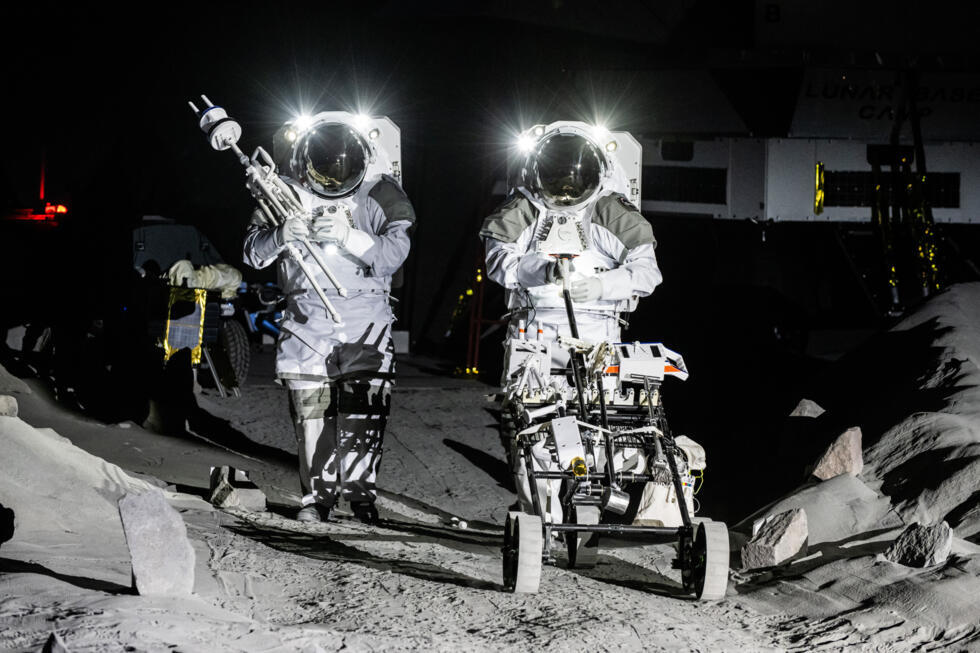
Cologne – At the edge of Cologne, Germany, a large industrial building contains something extraordinary: the most advanced simulated lunar environment on Earth. Developed jointly by the German Aerospace Center (DLR) and the European Space Agency (ESA), this facility — known as LUNA — is designed to prepare astronauts, robots, and technologies for a new era of moon exploration.On the 50th anniversary of the creation of the ESA, RFI English went to visit it.
Far from being a film set or museum piece, LUNA is a testbed for the future. It supports not only astronaut training but also the development of new tools and systems for operating in the harsh lunar environment. The facility sits within the European Astronaut Centre (EAC), ESA’s hub for human spaceflight activities.
A giant sandbox for space science
At the heart of the facility lies 780 tonnes of lunar soil simulant, carefully engineered to match the physical and chemical properties of regolith — the powdery, abrasive dust that covers the moon’s surface.
“We’ve produced approximately 780 tonnes of regolith material here. We based this material on what we understand the moon is made of. We know from the time of Apollo — we know from the samples they brought back — what the moon is comprised of,” Aidan Cowley, EAC Spaceship Coordinator, ESA, told RFI.
ESA at 50: looking back and launching forward
This simulated terrain is split across two key zones:
- A deep-area floor, around 3 metres deep and filled with 1.5 metres of regolith. This allows researchers to simulate tasks like drilling, buried excavation, and even the creation of craters for navigation or scientific study.
- A shallower flat area, ideal for testing rover movement, tool handling, and mobility exercises.
These physical scenarios help scientists refine operational techniques before any real astronauts step onto the moon again.

Preparing for lunar reality
Although the Artemis programme led by NASA is receiving much of the public attention, ESA is a key partner, contributing the European Service Module for Orion spacecraft and playing a leading role in astronaut training and surface operations.
ESA plans to send European astronauts to the moon through international collaboration. Facilities like LUNA help ensure these missions will be well-prepared, safe, and efficient.
Training includes:
- Geological sampling techniques, to study lunar history.
- Locomotion practice in simulated lunar gravity.
- Testing how astronauts and robots can work together in real-time scenarios.
The controlled environment allows teams to rehearse scientific tasks and problem-solving in ways that mimic the challenges of operating on the moon’s surface — where every movement is slowed by gravity, and communication back to Earth can be delayed.
ESA at 50: five decades of space innovation and cosmic achievements
Why lunar dust matters
Lunar dust may look soft and harmless, but it’s one of the greatest challenges facing space missions. The regolith is sharp, fine, and gets into everything — from spacesuit joints to camera lenses.
“The Moon is comprised of this regolith material... It’s a really interesting material. It’s quite aggressive. It’s very dusty. It infiltrates everything from mechanisms to seals to equipment. So it’s also a hazard, and it’s something we have to respect when we go there,” Cowley added.
Dust can degrade equipment rapidly, reduce the efficiency of radiators, and damage delicate electronics. Testing gear in this simulated environment allows engineers to improve sealing systems and develop new dust-resistant materials.
First commercial launch of Europe's Ariane 6 carrying French military satellite
Building with moon dust
Beyond training and testing, researchers at LUNA are experimenting with how lunar regolith could be used as a building material — a key step toward long-term human presence on the moon. Using materials sourced on the Moon, rather than sending supplies from Earth, could drastically reduce mission costs and improve sustainability.
“We’ve actually taken regolith sand, and we’ve used it combined with a small amount of polymer filler... and by combining it together you get the ability to make the plastic stick the regolith together and produce things that are very easy to make into different shapes like bricks or tools,” Cowley said.

This kind of in-situ resource utilisation (ISRU) is at the core of ESA’s vision for space exploration. If structures can be 3D-printed or assembled using local materials, future astronauts could build shelters, landing pads, or even radiation shields on site — vital for staying longer and travelling farther into the solar system.
A strategic asset for Europe
The LUNA facility gives Europe a critical platform to contribute to global Moon missions, including NASA’s Artemis programme and ESA’s own lunar plans. As international momentum builds toward a sustained human presence on the Moon, this facility will ensure Europe remains at the forefront of science, technology, and exploration.
By offering a controlled, flexible testbed for both human and robotic operations, the LUNA facility is not just a scientific playground — it is a proving ground for the future of space.







